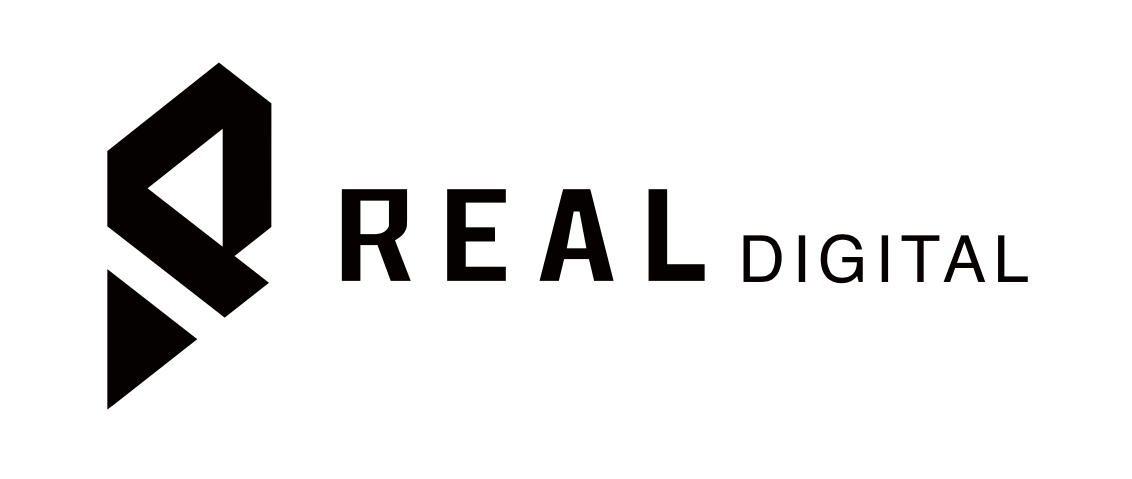How To Create An Amazon Seller Account
Welcome aboard, future Amazon entrepreneur! Whether you’re a passionate hobbyist, a budding business owner, or an ambitious individual seeking new avenues for success, embarking on your journey as an Amazon seller marks an exciting step toward realizing your dreams. We’ll navigate the ins and outs of setting up your seller account, offering valuable insights, practical tips, and encouragement to empower you on your path to entrepreneurial achievement. So, fasten your seatbelt because the adventure of a lifetime awaits – let’s dive into the exhilarating world of Amazon selling and turn your aspirations into reality!
Key Points Before Creating An Amazon Seller Account
Before registering an Amazon seller account, ensure you have your ducks in a row to fill out the requirements correctly. Here are some steps you should pay attention to:
1. Figure Out Your Business Model
The first step is to determine your business idea. When starting, you can use various business methods, including private labeling, wholesaling, online arbitrage, retail arbitrage, drop shipping, and Amazon Handmade.
- Private labeling: Build your brand by buying generic products from manufacturers, modifying them with your logo, and selling them under your brand name on Amazon. It gives you more control over your items but takes a significant investment in branding, marketing, and inventory management.
- Wholesale: A business concept in which you buy things in bulk from manufacturers or distributors at a discount and sell them on Amazon. It entails developing relationships with suppliers and properly managing inventory.
- Online Arbitrage: Similar to retail arbitrage, online arbitrage is sourcing things from online marketplaces or websites and profitably selling them on Amazon. This technique involves considerable research and expertise in online marketplaces.
- Retail Arbitrage: The method entails purchasing discounted or clearance items from retail stores and reselling them on Amazon for an excellent price. It requires careful monitoring of pricing changes and product demand.
- Dropshipping: Dropshipping entails partnering with suppliers who ship products directly to customers upon receiving orders. As a seller, you are not required to maintain inventory, but you will have less control over product quality and fulfillment.
- Handmade/Crafts: You can sell your unique handmade or created products on Amazon’s Handmade platform. This method appeals to craftsmen and artisans who want to display their work.
2. Select Your Fulfillment Method
Once you’ve decided on your business model and product, it’s time to plan your fulfillment method. You have two basic options: Fulfillment by Amazon (FBA) or Merchant. There are advantages and disadvantages to both FBA and FBM, but we strongly recommend FBA because the benefits outweigh the costs.
FBA allows you to join Amazon Prime, which results in faster shipment times (as Amazon customers have come to expect). Slow speed times may result in bad reviews, affecting your ability to persuade customers to buy and lowering your chance to rank well in Amazon’s search engine.
3. Identify Your Supplier
Now that you’ve determined the business model, product, and shipping method, it’s time to look for a supplier for the product. If you’re conducting retail arbitrage, it’s simple: your supplier is Walmart, Target, etc. However, if you employ a private label business model, you must locate a supplier. Before you start buying in quantity, ensure the products are inspected, and be aware that negotiating the price down may result in a lower-quality product, which you should avoid at all costs. A lower-quality product will likely receive bad reviews (mainly if you use the Amazon Vine Program), so avoid them at all costs.
4. Compile Your Product and Store Information
Firstly, compiling product information requires thorough documentation of the items you plan to list on Amazon. This includes providing precise, concise details such as the product name, description, and critical features. High-quality images from various angles should be gathered to effectively showcase the product’s appearance. Additionally, determining the pricing strategy for each product and assigning unique identifiers (SKUs) are essential steps in managing inventory and facilitating sales.
Secondly, organizing store information involves creating a cohesive and compelling presence for your Amazon storefront. This includes choosing a memorable store name and crafting an engaging “About Us” section that communicates your brand’s story, mission, and values. Developing branding elements such as a logo, color scheme, and visual identity helps establish a consistent brand presence. It’s also important to outline store policies related to shipping, returns, and customer service to set clear expectations for buyers. Accurate contact information enables customers to reach out with inquiries or concerns, fostering trust and confidence in your brand.
By meticulously compiling product and store information, you can create compelling product listings and establish a trustworthy professional presence on Amazon. This attracts potential customers and enhances their shopping experience, ultimately driving sales and fostering long-term growth for your business.
How To Create An Amazon Seller Account Step By Step
Let’s dive into the exhilarating world of Amazon selling and turn your aspirations into reality! We’ll show you step-by-step instructions on how to create an Amazon Seller Account.
1. Visit Amazon Seller Central and Click ‘Sign Up’
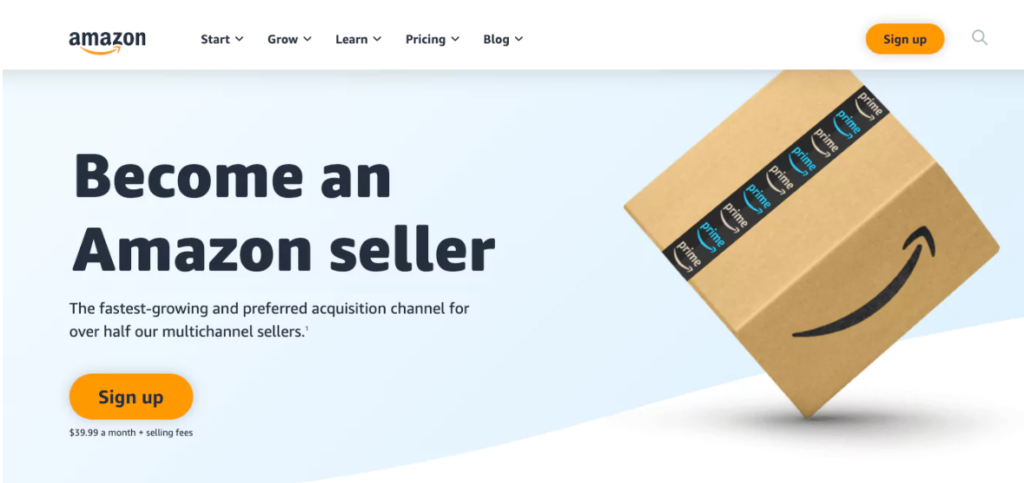
2. Select ‘Create Your Amazon Account’
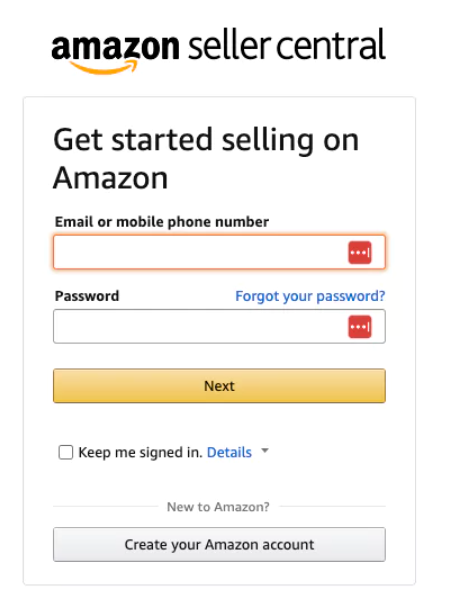
3. Verify Your Email Address
After you submit that information, Amazon will give you a code to verify your email. After entering the code, you will be brought to this screen. This page explains what you’ll need to complete your account registration: A valid government-issued ID or passport, a recent bank or credit card statement, a credit card that can be charged, and a mobile phone.
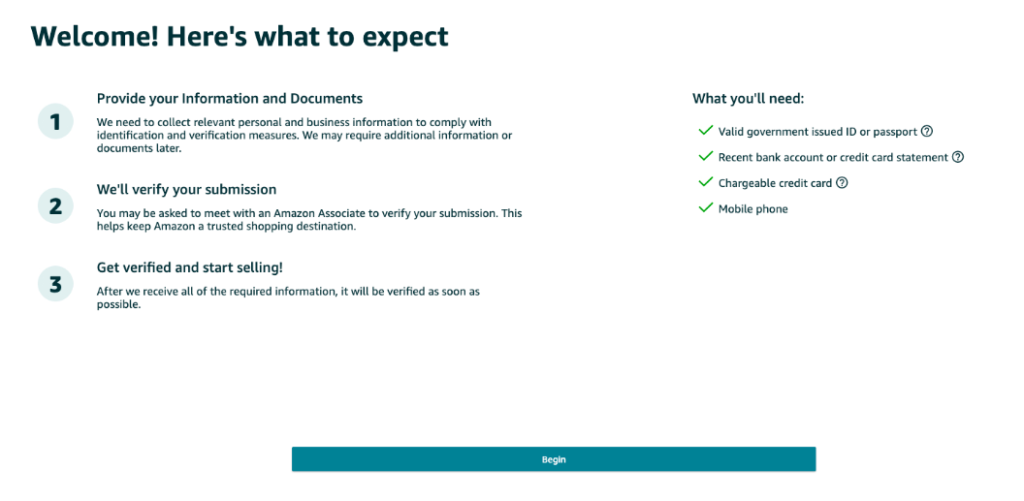
4. Choose Your Business Location and Business Type
Next, you’ll choose your business’s location and type. You must pick the country where your business is located. For your business kind, you will select from the following options: state-owned, publicly owned, privately owned, charity, or None; I am an individual. For context, most sellers will select privately owned enterprises. If you haven’t started a business, select ‘None, I am an individual.’
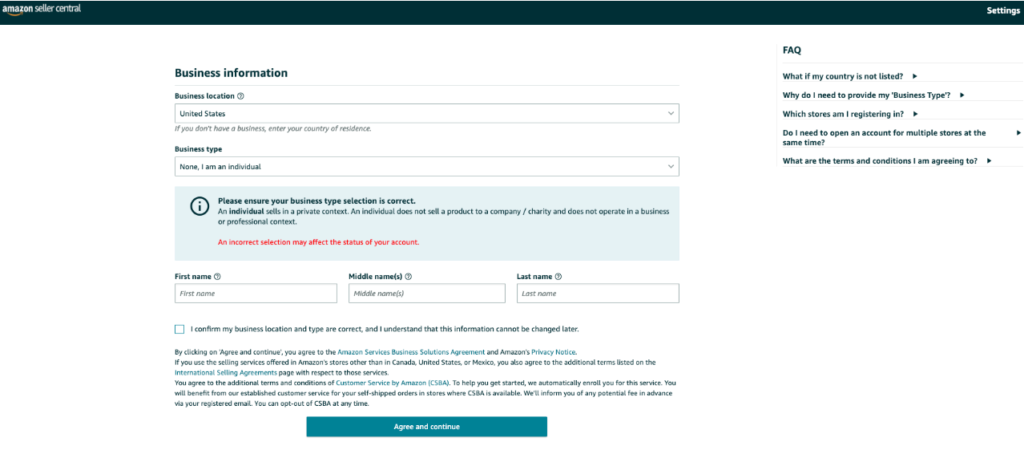
5. Enter the Seller and Billing Information
You will be asked to submit personal information so that Amazon can verify your identification and contact you if necessary. You must also confirm your phone number via text message or call. Amazon will email you a PIN, which you must enter to have your number validated.
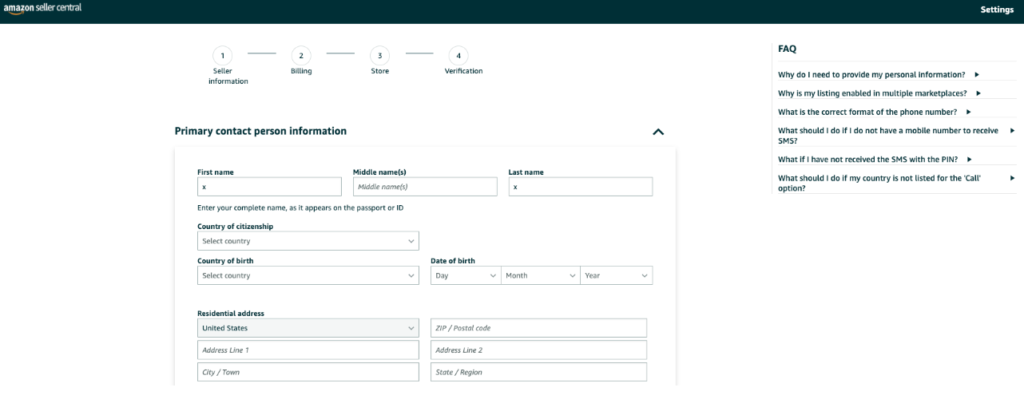
You will be required to enter a legitimate bank account number; therefore, have your bank account details ready while going through this process. It will deposit and withdraw funds from your bank and Amazon payment accounts. Your bank account must be in the primary contact or business name you selected earlier. Amazon will require a copy of your bank statement to verify your account information. You must also provide a valid credit card number, which will be used to pay your selling plan fees.
6. Enter Your Product and Store Information
After providing your seller and billing details, you must provide information about your products and the Amazon store. It would be best to name your Amazon store (you can change it later). Next, tell Amazon whether you have UPCs for your products, have any diversity certificates, and know who makes or owns any products you wish to sell on Amazon.
7. Verify your identity
The final step will require you to verify your identity. This allows Amazon to ensure that the Amazon marketplace is a safe and fair environment for both sellers and buyers. You must provide a bank statement and an image of your ID, which might be a license or passport.
Once you’ve submitted both, you must complete an Identity Verification via video conference with an Amazon associate. During this call, the Amazon associate will confirm all the information and documentation you provided. After this video conference, you will have completed opening your Amazon seller account!
Tips For Beginners To Be Success On Amazon
Here are the tips to help beginners excel on Amazon; we’ll help you discover essential strategies for success here:
1. Source from Reliable Manufacturers and Test Product Quality
Sourcing products from reliable manufacturers is crucial for ensuring the quality and reliability of your inventory on Amazon. Beginners should conduct thorough due diligence when selecting manufacturers, verifying their reputation, production processes, and quality control measures.
Requesting product samples allows sellers to evaluate the quality firsthand and assess whether the products meet their standards and specifications. Testing product quality is essential for building trust with customers and minimizing the risk of negative reviews or returns, ultimately contributing to long-term success on Amazon.
2. Enroll in Amazon Brand Registry
Enrolling in the Amazon Brand Registry offers numerous benefits for sellers looking to establish and protect their brand identity. By registering your brand, you can access tools and features that enhance brand protection, such as proprietary text and image search, proactive brand protection measures, and enhanced content options for product listings.
Brand Registry also provides greater control over product listings, allowing sellers to create a more cohesive and professional brand presence on Amazon. Protecting your brand and optimizing your product listings can enhance visibility, credibility, and sales potential, setting the stage for long-term success as an Amazon seller.
3. Participate in the Amazon Vine Program
The Amazon Vine Program offers sellers a valuable opportunity to generate authentic reviews from trusted reviewers before their products are publicly available. Participating in the Vine Program allows sellers to send free products to Vine Voices, who provide honest feedback and reviews based on their experiences.
These reviews can significantly impact product visibility, credibility, and sales conversion rates on Amazon, as they are labeled as Vine reviews and carry weight with potential buyers. By leveraging the Vine Program, beginners can kickstart their product launch with positive reviews from reputable sources, establishing a positive reputation for their brand and driving sales momentum.

4. Implement Amazon PPC Advertising
Amazon PPC (Pay-Per-Click) advertising is a powerful tool for increasing product visibility, driving targeted traffic, and maximizing sales on the platform. Beginners should develop strategic advertising campaigns targeting relevant keywords and audiences to promote their products to potential customers effectively.
By bidding on keywords and setting ad budgets, sellers can control their advertising spend while optimizing campaign performance and ROI. Monitoring performance metrics such as click-through rates, conversion rates, and advertising costs allows sellers to refine their campaigns and maximize their advertising effectiveness over time. With strategic PPC advertising, beginners can boost product visibility, drive sales, and accelerate growth on Amazon.
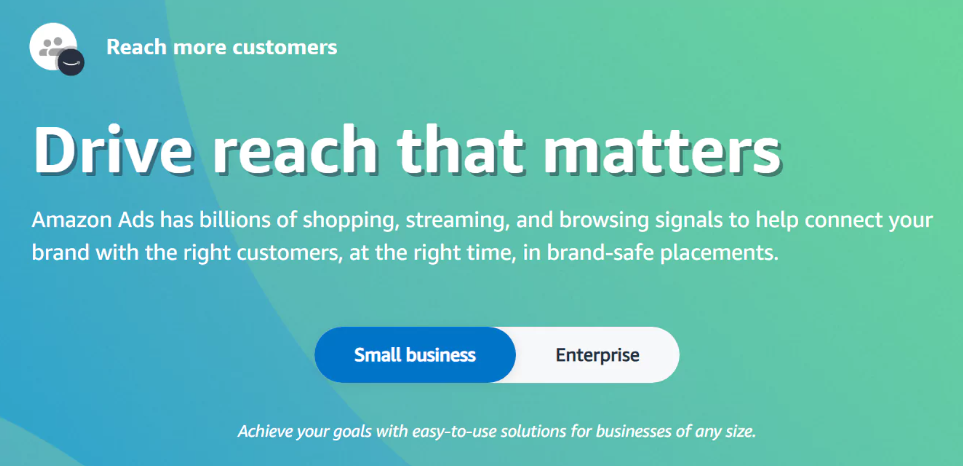
5. Establish a Shopify Website
Establishing a Shopify website provides sellers with a branded online storefront outside of Amazon, offering additional sales channels and opportunities for growth. Beginners can customize their Shopify website to reflect their brand identity, showcase their products, and provide a seamless shopping experience to customers. Integrating Shopify with Amazon allows sellers to streamline inventory management, order fulfillment, and sales synchronization between the two platforms. By diversifying their sales channels and building a direct relationship with customers through Shopify, beginners can reduce dependency on Amazon and enhance their brand’s resilience and sustainability in the e-commerce landscape.
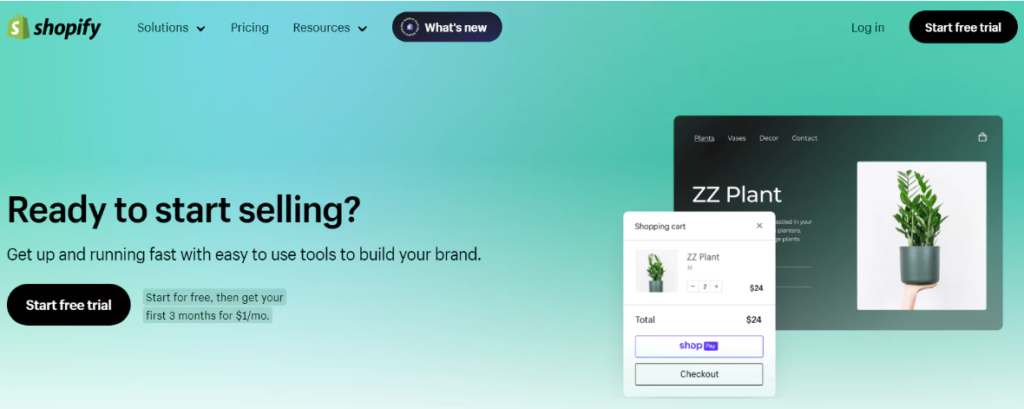
Is it free to make an Amazon account?
Yes, it is free to create an Amazon account. Amazon allows users to sign up for an account at no cost, enabling them to browse products, make purchases, access digital content, manage orders, and utilize various features such as wish lists and customer reviews. Creating an Amazon account requires only basic information such as an email address, name, and password. However, certain services on Amazon, such as Amazon Prime membership or purchasing digital content, may require payment or subscription fees. Nonetheless, the basic functionality of having an Amazon account is entirely free.
How long does it typically take to start making sales after creating an Amazon seller account?
The time it takes to start making sales on Amazon after creating a seller account can vary significantly depending on various factors, including the product category, competition, pricing, marketing efforts, and the quality of your listings. Some sellers may begin making sales within a few days or weeks, primarily if they sell in high-demand categories with less competition or have existing marketing channels to drive traffic to their Amazon listings.
However, others may take weeks or months to gain visibility, attract customers, and generate consistent sales. New sellers must optimize their product listings, utilize Amazon advertising and promotional tools, and employ effective marketing strategies to accelerate sales. Building a successful presence on Amazon often requires patience, persistence, and ongoing optimization to achieve desired results.
How do I choose the right products to sell on Amazon?
To choose the right products to sell on Amazon, conduct thorough market research to identify high-demand niches with the manageable competition. Analyze competing products to understand pricing, features, and customer reviews, aiming to differentiate your offerings or add value to customers. Consider profitability, seasonality, and compliance with Amazon’s policies while evaluating potential products. Keep an eye on industry trends and emerging markets to capitalize on new opportunities, and consider testing products before committing to large-scale inventory. Ultimately, select products that align with your expertise, passion, and business goals to increase your chances of success on Amazon’s competitive e-commerce platform.
Conclusion
Succeeding on Amazon demands more than just setting up a seller account; it demands a keen ability to learn, adapt, and take action. Those who possess analytical skills, question outcomes, and persevere through initial setbacks are poised for success in this venture. For any inquiries about starting your business on Amazon, kindly book your Free consultation or get in touch here: [email protected]
